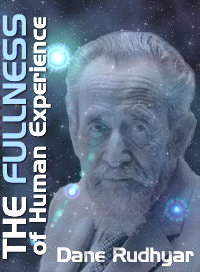 |
| Home | Bio | Art | Music | Literature | Civilization & Culture | Philosophy of Wholeness | Theosophy & Spirituality | Astrology |

CHAPTER FIVE
The Three Factors in Experience and Their Cyclic Transformation - 3 The expenditure and repotentialization of energy Energy, understood in its most fundamental nature, is the product of a dynamic state of relationship. The concept of Wholeness implies such a state, whose two polarities are the principles of Unity and Multiplicity. As these are polar opposites of equal strength, alternately and cyclically waxing and waning, the movement their relatedness produces is balanced. It is a state of dynamic equilibrium. The energy unceasingly generated by the harmonic process of bipolar relatedness is as constant as the structure of the cyclic relationship is invariant. In its most basic sense, the word Space (capitalized in order to avoid misunderstanding) refers to both the dynamic state of balanced relatedness and the energy inherent in it. Space is a plenum of energy because it is fullness of relationship. Any relationship implies what normally is called space. If there is no space (no dis-stance) between two entities, they cannot be considered related, provided we do not limit the idea of distance by thinking of it in terms measurable by physical yardsticks or any other material means of measurement; thus, in terms of what can properly be called "di-mension."(2) But this dimensional and measurable space is not Space (capitalized) any more than personal emotions are cosmic Motion, or the love/hate dualism that so often tears the integrality of human persons is the changeless relationship between the principles of Unity and Multiplicity. This relationship generates energy, and energy inheres in Space in both the potential and kinetic modes. Potential energy is expended as kinetic energy when the desire for its use arises in a subject confronted by a situation requiring the use of energy. The energy used does not vanish from Space; it becomes dis-organized. At least part of this energy ceases to be concentrated within the structure of a finite field of being in which a subjective factor is an active presence, able to manifest as a source of desires and perhaps of will. As this energy is used in various modes of activity, it becomes scattered and loses its cohesion. Yet it may also be re- potentialized and once more condensed within a field of being. The potential energy which had been kineticized and spent by the multitude of biological species in a biosphere almost frantic with differentiation and proliferation is repotentialized when the trend toward Unity asserts itself with sufficient power. However, this mainly occurs during the last phases of human evolution, still far in the future for the masses of humanity. It presumably is one of the functions of the planetary Pleroma. Today the type of expenditure of energy engendered by sociocultural and interpersonal relationships can already be controlled, neutralized, and repolarized as part of a process of conscious and willful repotentialization. I have already mentioned such a process in terms of a somewhat different frame of reference when speaking of asceticism, or the conservation of energy. This demands either attunement to the rising trend toward Unity, or an intense devotion to the Avatar who once gave concrete form to a new archetype — the great symbols and myths of the culture which developed mainly after the dissolution of the Avatar's bodily field of existence. Both approaches are valid, yet one of them is usually the dominant factor in a person whose dharma befits him or her for such a repotentializing activity. It should be clearly understood that energy is never created. Energy is the substratum required to enable any organized whole of being to experience Wholeness. But the quality and intensity of the experience is basically determined by the level of beingness at which this whole can operate. While the energy is always "here," it may be too diffuse to be useable in the fulfillment of a conscious or subconscious purpose. Space is a plenum of energy; yet the state of plenitude does not imply the possibility effectively to use what fills the space-field. There must also be condensation and concentration. In science, space can be thought of as a dimensionless mathematical point, but this is a strictly formalistic meaning, and Western science is indeed a formalistic system of interpretation of data provided by physical senses. (3) In a deeper sense. Space can be condensed in a nearly unextensive area (or core of being), or it can be diffused in terms of quasi-infinite extension. Yet, according to the philosophy of Operative Wholeness, Space and the plenum of energy it symbolizes can never reach a state of infinite density and become an absolute center of Beness, "the One." Neither can Space be absolutely fragmented and differentiated in an infinity of "ones" unable to experience any desire for relationship because they are synchronously deprived of useable energy. To repeat a previous point, there can be no absolute states of either Unity or Multiplicity — only states of maximum oneness or multiplicity which, when reached in a cycle, call forth at once a reversal of the Motion and radically alter the character of the ever-changing but always cyclically balanced experience of relatedness. Energy is usually defined as the capacity to perform work. As it performs work it operates in its kinetic mode; but before the performance mobilizes it, the energy is "present" in a potential state. It is mobilized or kineticized either by a natural change in a situation producing a basic need, or by some kind of intentional personal desire. As it passes from a potential to a kinetic state, energy seems to be "spent"; yet it is not lost. It merely changes state and passes to a lower level of potentiality, especially becoming heat. If it were continually spent for the satisfaction of a multitude of needs or desires, the energy potential of any organized system of activity would sooner or later be dissipated. This dissipating trend is what is now called entropy, and it would lead to a "dead level" of energy. However, entropy applies only to closed systems of being. In open systems an opposite process, negentropy, is also at work. This process manifests in a variety of ways. At the biological level we see it operating as eating and feeding (in the most general sense of the words). Through eating, the spent biological energy is restored; but restoration can only operate within relatively narrow limits, and the life-system that was born must die. It dies in a state of biological impotency. It must do so because the principle of Multiplicity aggressively dominates the realm of life-systems, and the principle of Unity can only maintain the operation of the system as a whole between two markers of time, birth and death 2. Two entities occupying the same area of space at the same time are not related; they constitute a single entity. The concept of knowledge through what is assumed to be "identification" is the result of a semantic confusion. Perfect resonance is meant, not identification. Similarly, a reflection is not the "real" source of the light-rays. Return 3. See Rhythm of Wholeness, chapter twelve, p. 198, for a definition of science. Return By permission of Leyla Rudhyar Hill Copyright © 1986 by Leyla Rudhyar Hill All Rights Reserved.  Web design and all data, text and graphics appearing on this site are protected by US and International Copyright and are not to be reproduced, distributed, circulated, offered for sale, or given away, in any form, by any means, electronic or conventional. See Notices for full copyright statement and conditions of use. Web design copyright © 2000-2004 by Michael R. Meyer. All Rights Reserved. |
 |
